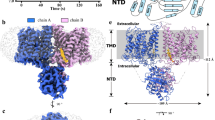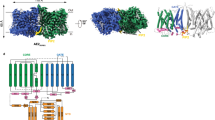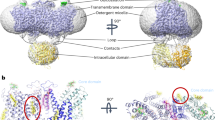Abstract
A plasma membrane anion exchange system allows the red blood cell to replace intracellular bicarbonate rapidly with extracellular chloride to facilitate carbon dioxide release into the lungs. The protein responsible for this exchange is a glycoprotein of molecular weight about 93,000, called band 3, which comprises approximately 25% of the total red cell membrane protein and is present in the membrane as a non-covalent dimer1. The molecular mechanism of anion transport remains obscure, in spite of the characterisation of the extracellular anion binding site by a number of methods including interactions with disulphonic stilbene probes which act as specific inhibitors of anion exchange2. One of these compounds (4,4′-diisothiocyano-2,2′-disulphonic stilbene; DIDS) causes complete inhibition of anion exchange by reacting at approximately one site per band 3 monomer (∼2.5 nmol per mg protein)3. A fluorescent DIDS analogue, DBDS (4,4′-dibenzoamide-2,2′-disulphonic stilbene), binds reversibly and specifically to the DIDS reactive site where it also inhibits anion exchange6 . When bound, the fluorescence intensity of DBDS increases by two orders of magnitude and this has enabled us to investigate the binding kinetics of DBDS to red blood cell ghost membranes by fluorescence equilibrium and temperature-jump methods. Our equilibrium binding data indicate that there are two classes of DBDS binding sites on red cell ghosts. The reaction scheme that we present here suggests that the apparent high affinity (15–60 nM) for binding the first DBDS molecule is the result of a two step process: an initial binding of lower affinity (K1∼0.5 µM) to band 3 followed by a slow conformational change (∼5 s−1) in the binding site which acts to lock the DBDS molecule in place. A second DBDS molecule binds with low affinity (∼3 µM) to a site which is more difficult to characterise.
This is a preview of subscription content, access via your institution
Access options
Subscribe to this journal
Receive 51 print issues and online access
$199.00 per year
only $3.90 per issue
Buy this article
- Purchase on Springer Link
- Instant access to full article PDF
Prices may be subject to local taxes which are calculated during checkout
Similar content being viewed by others
References
Steck, T. L. J. supramolec. Struct. 8, 311–324 (1978).
Cabantchik, Z. I., Knauf, P. A. & Rothstein, A. Biochim. biophys. Acta 515, 239–302 (1978).
Ship, S., Shami, Y., Breuer, W. & Rothstein, A. J. Membrane Biol. 33, 311–323 (1977).
Dodge, J. T., Mitchell, C. & Hanahan, D. T. Archs Biochem. Biophys. 100, 119–130 (1963).
Lowry, O. H., Rosenbrough, N. J., Farr, A. L. & Randall, R. J. J. biol. Chem. 193, 265–275 (1951).
Rao, A., Martin, P., Reithmeier, R. A. F. & Cantley, L. C. Biochemistry 18 (in the press).
Eigen, M. & DeMaeyer, L. in Techniques of Organic Chemistry (eds Friess, S. L., Lewis, E. S. & Weissberger, A.) 895–1055 (Wiley, New York, 1963).
Verkman, A. S., Pandiscio, A. A., Jennings, M. & Solomon, A. K. Anal. Biochem. (in the press).
Czerlinski, G. H. Chemical Relaxation (Dekker, New York, 1966).
Verkman, A. S. thesis, Harvard University, MA (1979).
Author information
Authors and Affiliations
Rights and permissions
About this article
Cite this article
Dix, J., Verkman, A., Solomon, A. et al. Human erythrocyte anion exchange site characterised using a fluorescent probe. Nature 282, 520–522 (1979). https://doi.org/10.1038/282520a0
Received:
Accepted:
Published:
Issue Date:
DOI: https://doi.org/10.1038/282520a0
This article is cited by
-
Conformational changes in human red cell membrane proteins induced by sugar binding
The Journal of Membrane Biology (1991)
-
Interaction among anion, cation and glucose transport proteins in the human red cell
The Journal of Membrane Biology (1989)
-
Renal basolateral membrane anion transporter characterized by a fluorescent disulfonic stilbene
The Journal of Membrane Biology (1987)
-
Binding of chloride and a disulfonic stilbene transport inhibitor to red cell band 3
The Journal of Membrane Biology (1986)
-
Characterization of the Band 3 substrate site in human red cell ghosts by NDS-TEMPO, a disulfonatostilbene spin probe: The function of protons in NDS-TEMPO and substrate-anion binding in relation to anion transport
The Journal of Membrane Biology (1986)
Comments
By submitting a comment you agree to abide by our Terms and Community Guidelines. If you find something abusive or that does not comply with our terms or guidelines please flag it as inappropriate.



